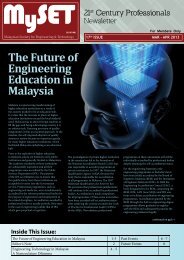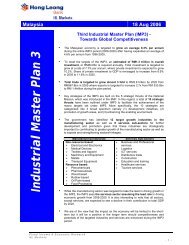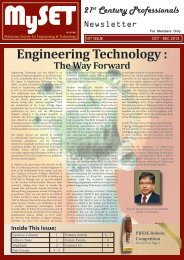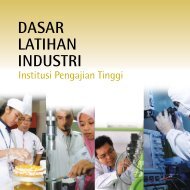PROGRAMME STANDARDS: ENGINEERING ... - DrJJ
PROGRAMME STANDARDS: ENGINEERING ... - DrJJ
PROGRAMME STANDARDS: ENGINEERING ... - DrJJ
You also want an ePaper? Increase the reach of your titles
YUMPU automatically turns print PDFs into web optimized ePapers that Google loves.
<strong>PROGRAMME</strong> <strong>STANDARDS</strong>: <strong>ENGINEERING</strong> & <strong>ENGINEERING</strong> TECHNOLOGY<br />
such as Work Ethics,<br />
Sustainable Issues and<br />
Entrepreneurship.<br />
II.<br />
Discipline Core<br />
To be determined by the institutions<br />
80 – 84<br />
(inclusive of a Final Year Project<br />
of 8 – 10 credits)<br />
according to the needs of the<br />
programme.<br />
(50% of which must<br />
be practical hours)<br />
INDUSTRIAL TRAINING<br />
Attachment to a relevant workplace. 8 – 12<br />
ELECTIVE MODULES<br />
- 8 – 14<br />
*Credits calculated are based on the Minimum Graduating Credits stated above.<br />
Note:<br />
With the conventional credit-hour system based on contact time, higher credit hours implied that<br />
students had learned more. This is no longer true with the credit-hour system based on student<br />
learning time. The delivery method and learning activities designed for the course have a much<br />
bigger influence on the credit hours. A course delivered mainly through lectures and self study<br />
would result in lower credit hours compared to that being delivered through lectures and<br />
reinforced with formal hands-on activities and self study. As such, one can expect the credit<br />
hours for the former to be less compared to the latter.<br />
It follows that the credit hours for an engineering programme can be lower compared to that of<br />
an engineering technology programme. This is so because an engineering programme is more<br />
theory-based compared to an engineering technology programme which takes a more hand-on<br />
approach, thus requiring more time. The higher credit hours on engineering technology<br />
programmes simply indicate that more student learning time is allocated in the programme so<br />
that students are able to understand and to apply the knowledge that is taught.<br />
Page 21 of 53









